As violence and vandalism escalate in Hong Kong, some protest supporters have had enough

Six Hong Kong residents who spoke to CNN for this story requested anonymity because they feared being targeted for their comments. Jose asked we only use her last name. "Millie," "Sarah," "Marcus," "Yara," and "Patrick" requested pseudonyms.
(CNN)For most of the summer, 25-year-old Jose was an ardent supporter of the protests raging in Hong Kong. Even when demonstrations became increasingly violent, she defended the protesters themselves -- they were provoked, or were fighting for a greater good, she would argue.
Then August 13 happened. That night, she watched live streams, horrified, as a mob of protesters at Hong Kong airport surrounded a man they claimed was an undercover police officer. They bound his wrists, lashed out at him after he appeared to lose consciousness, and shouted down those who pleaded to get him medical attention.
"I remember being in disbelief, looking at my TV -- like, what's happening? Why have they done this?" Jose said. "Up until that day, I'd understood what they were fighting for ... I went back into my room and sat there looking at my wall for a very long time."
Hong Kong protesters' 5 demands
- Fully withdraw the extradition bill
- Set up an independent inquiry to probe police brutality
- Withdraw the characterization of protests as "riots"
- Release those arrested at protests
- Implement universal suffrage in Hong Kong
The airport incident marked one of the defining moments in the protests, which began in June with peaceful mass marches against a now-withdrawn bill that would have allowed extradition to mainland China, among other countries. It has since spiraled into a broader pro-democracy, anti-government movement, with protesters laying out five major demands -- only one of which has been met.
Both sides accuse the other of using excessive violence, and provoking the use of police tear gas and protester petrol bombs. Even Hong Kong itself is covered with marks of the unrest, with shops vandalized and boarded up, and many subway station entrances charcoal-black from fires set by protesters.
However with no clear end in sight, new divisions appear to be emerging in the city -- besides the hardcore protest frontliners and fierce opponents, now there are wavering sideline supporters and moderates who say they have been driven away by the violence.
When does it go too far?
Most people have a different answer over whether the unrest has crossed the line. Protesters say they're not there yet because they haven't killed or seriously injured anyone -- if anything, they think the police are the ones who have gone too far.
Marcus, a 22-year-old protester, said he drew the line at "unneeded violence" -- but like many in the movement, he saw their actions as largely justified. For instance, he felt the airport violence went too far, but quickly pointed out that the mob had allegedly found evidence the man was an undercover police officer.
"When you're in a situation like that, no one has time to be like, let me fact-check this," he said. "The proof was there in his bag."
Marcus' stance reflects an apparently common attitude among the movement and its sympathizers -- a vague opposition to violence, but an instinct for leniency when it comes to the protesters. "If we lose, it's called a riot," said Yara, a 22-year-old education consulting employee. "But if we win, it will be called a revolution, and all the violence will be for good, ultimately."

Protesters set a Bank of China branch on fire in Hong Kong on October 13, 2019.
Multiple protesters who spoke with CNN returned to this perceived image of a greater good. They say they fear Hong Kong will lose its protected freedoms of speech, press and assembly, and that the semi-autonomous city will ultimately be swallowed up by mainland China.
When faced with such a fate, real or perceived, the demonstrators say little else seems to matter. Transit woes, missed flights, even disrupted education -- to them, these all seem like worthy sacrifices for a movement they believe could save the city.
Critics in the "silent majority"
Standing in sharp contrast on the other side are members of the self-dubbed "silent majority" -- people who oppose the unrest. They argue that the protesters are spreading chaos and fear across the city, trashing the economy, and hurting not just their own cause but everybody caught in the crossfire.
It's unclear how many people are actually in the "silent majority," or if they really are a majority at all, but the group appears to be slowly growing -- publicly at least. One Facebook group critical of the protests has amassed more than 125,000 members in two months.
For comparison, one of the largest protest groups on the encrypted messaging app Telegram has about 240,000 members.
Many say there can be no pardoning of the protesters' violence and vandalism. To do so would effectively justify violence against anybody with a different view, they say, and open the door to dangerous polarization and censorship.

Hong Kong's self-dubbed "silent majority" held a rally in support of the police on July 20, 2019.
Even more sinister than the destruction itself is "the acceptance from the anti-government people," said Patrick, 26, who also initially supported the demonstrators' right to peaceful protest before the situation escalated.
He accused supporters on the sidelines of expressing "no condemnation" -- meaning they were either scared to speak out against the movement, or truly believed that violence was right. He said he doesn't know which is worse.
"I think that's the scary part -- not just the action itself, but the reaction to the action," he added.
Some protesters have apologized for mistakenly vandalizing politically neutral shops, and for the airport mob attack. But many say it's not enough.

Demonstrators hold an apology sign at the Hong Kong International Airport on August 14, 2019.
"There's no trial and error when it comes to violence," said Sarah, 41. She supported the peaceful mass marches in June, but started withdrawing her support when protesters began vandalizing the subway, attacking police officers, and leaking private information about the officers' families online.
Millie, a 39-year-old banking industry employee, said the protesters' disruption of transit systems was not merely an inconvenience, but an infringement on regular people's right to daily life.
"They're taking a piece of freedom from that person to travel," she said. "Blocking people -- which is their freedom to go about their own business -- that's the line for me."
Among this "silent majority," they also talk of a simple bewilderment -- if the protesters want democracy, why are they smashing ATMs? What does vandalizing the subway system have to do with universal suffrage?
When given the protesters' reasons -- that the ATMs belong to Chinese-owned banks, that protesters believe the subway operator is in cahoots with the police -- the critics interviewed by CNN wave them away as alarmist, counterproductive, or as Sarah put it, just plain "stupid."
"Even if the government cornered them, that doesn't legitimize the violence," she said. "The law is the law. You don't hurt people, you don't break government property."

Police fire blue dye toward protesters in Hong Kong on Sunday, October 20. Blue dye can be used to stain and identify masked protesters.

Protesters set fire to a shop on October 20.

Police charge during a pro-democracy march in the Kowloon district on October 20.

Protesters scatter as tear gas fills a street in Hong Kong on October 20.

A protester sets fire to a Bank of China branch on October 20.
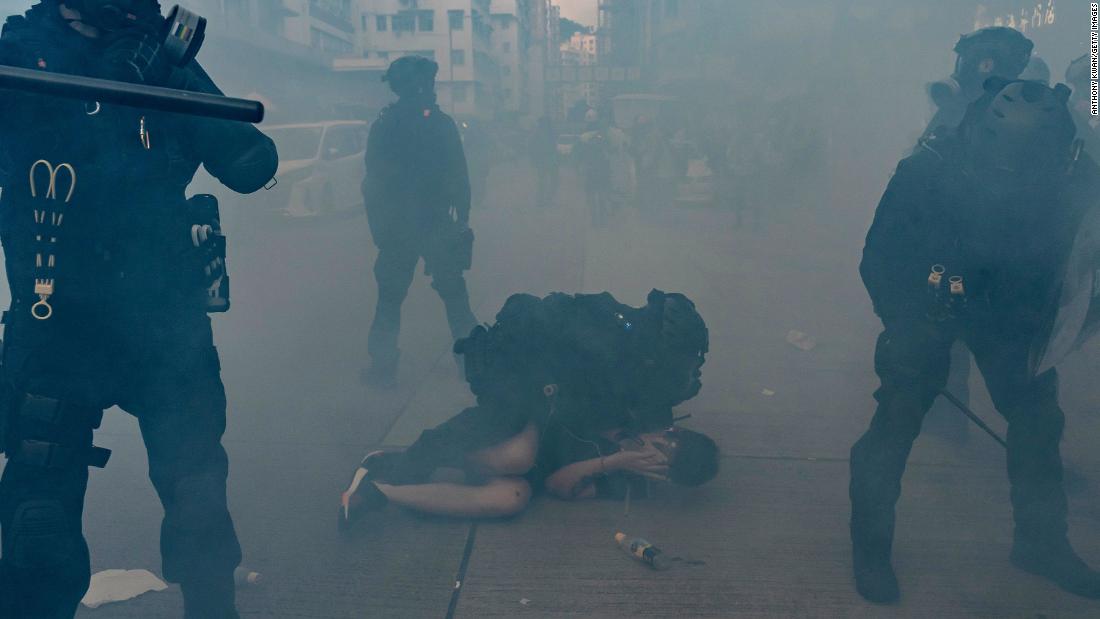
A pro-democracy protester is arrested by police on October 20.

Pro-democracy lawmakers protest as Hong Kong Chief Executive Carrie Lam delivers a speech at the Legislative Council on Wednesday, October 16. Lam's annual policy address ended in chaos as pro-democracy lawmakers repeatedly disrupted her speech and heckled her with calls to honor the demands of anti-government protesters.

Lam arrives at the Legislative Council on October 16.

A protester shoots a basketball at a poster of Lam during a rally on Tuesday, October 15.

Protesters set fire to a Bank of China branch on Sunday, October 13. It was the 19th consecutive weekend of anti-government protests in Hong Kong.

Protesters use the lights on their phones during a rally in central Hong Kong's business district.

A protester attempts to break a tourist bus window on October 13.

Protesters wearing masks in defiance of a recently imposed ban gather at a shopping mall on October 13.

Anti-government protesters set up "The Lady Liberty of Hong Kong" statue, which symbolizes the city's recent democratic movement. The figure stands a little over 13 feet tall and was carried in pieces to the top of Lion Rock, one of Hong Kong's iconic peaks.

Protesters vandalize a shopping mall restaurant on October 13.

Supporters surround a police bus carrying political activist Edward Leung as it leaves the High Court in Hong Kong on Wednesday, October 9. Several hundred masked protesters gathered at Hong Kong's High Court for the appeal hearing of Leung, who was sentenced to six years in prison for his part in a violent clash with police.

Police shine lights at protesters outside the Ma On Shan police station on October 9.

Protesters smash up a Bank of China branch on Monday, October 7.

A woman is treated after police fired tear gas to disperse protesters in the Mong Kok district of Hong Kong on October 7.

Police clear a street as protesters and pedestrians gathered near the Mong Kok police station on October 7.

Pro-democracy protesters gather in a shopping mall on October 7.

A masked protester stops for a portrait in Hong Kong on Sunday, October 6.

Protesters vandalize the Cheung Sha Wan local government offices on October 6.
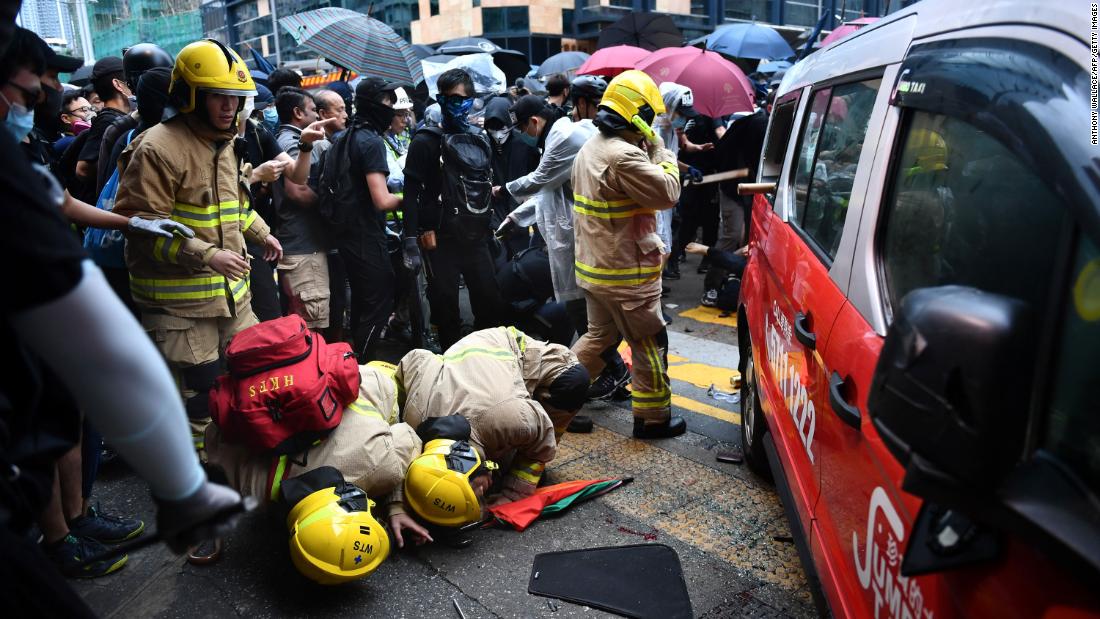
Rescue personnel check the bottom of a taxi after the driver allegedly drove onto the pavement, hitting protesters in Hong Kong on October 6.

A China Construction Bank is seen vandalized in the Causeway Bay area of Hong Kong on October 6.

Pro-democracy protesters set fires in the street in the Causeway Bay area.
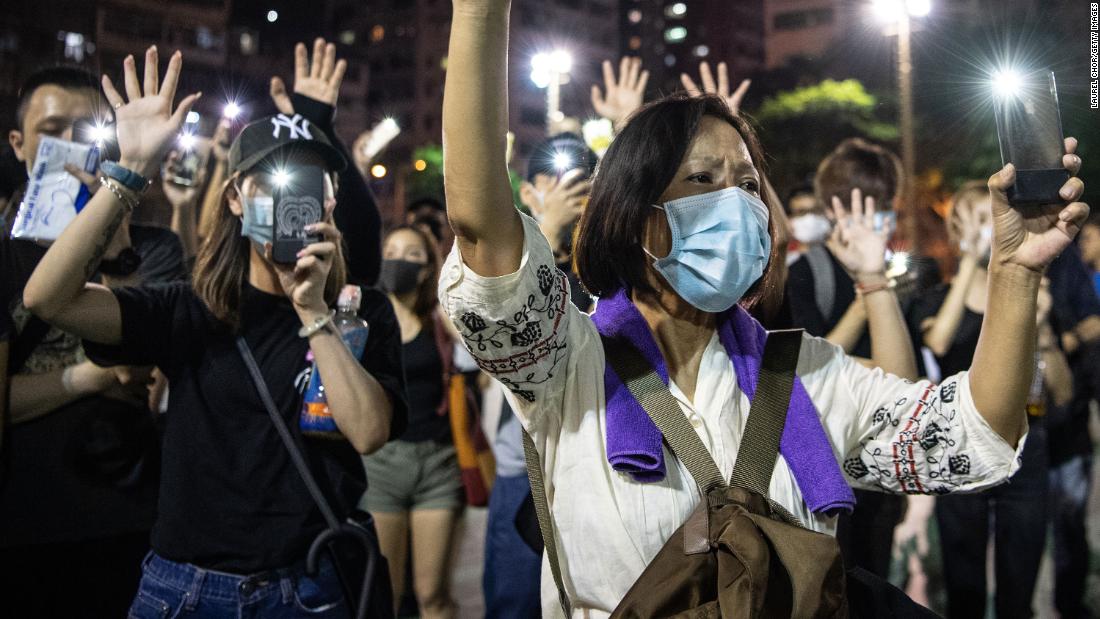
People protest the ban against masks on Saturday, October 5.

Police detain a protester on October 5.

An anti-government protester stands near a fire on Friday, October 4.

Protesters move a statue depicting a protester armed with gas mask, helmet and umbrella on the streets of Hong Kong on October 4.

Protesters set a fire at a China Construction Bank.

Police deploy tear gas outside a restaurant during a protest in the Causeway Bay district.

Protesters spray paint slogans at the entrance to a tunnel on October 4.

A fire is seen in front of a store vandalized by protesters.

A store after being vandalized by protesters.
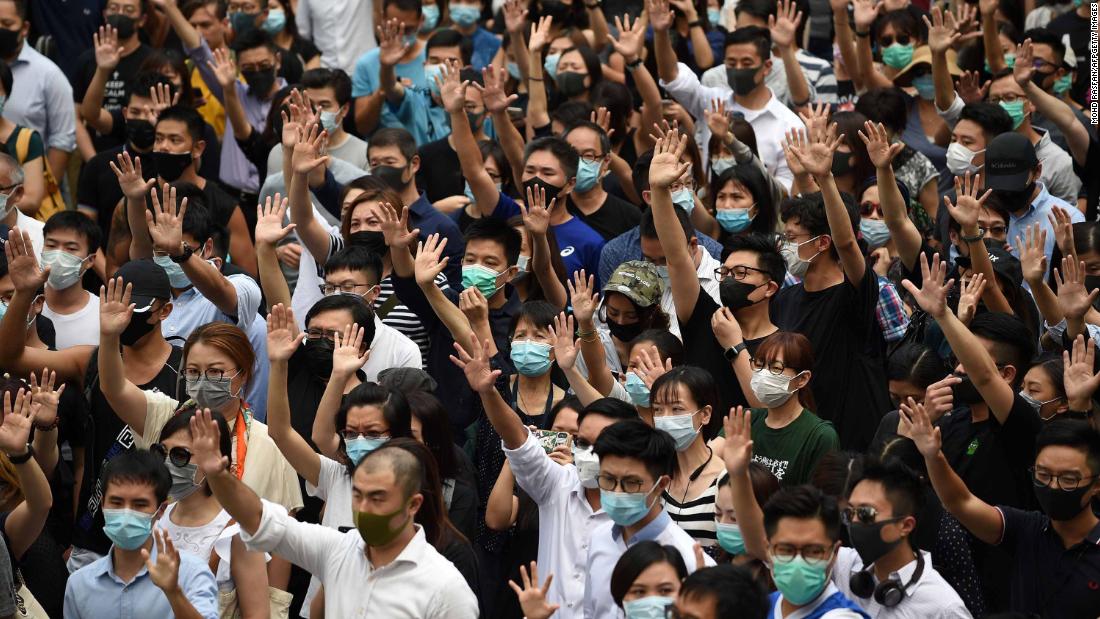
Pro-democracy demonstrators hold up their hands to symbolize their five demands during a rally on October 4.

Protesters throw petrol bombs at the gate to the Tsuen Wan police station on Wednesday, October 2.

Schoolmates of a student who was shot in the chest by police place their hands on their chests during a protest on October 2.
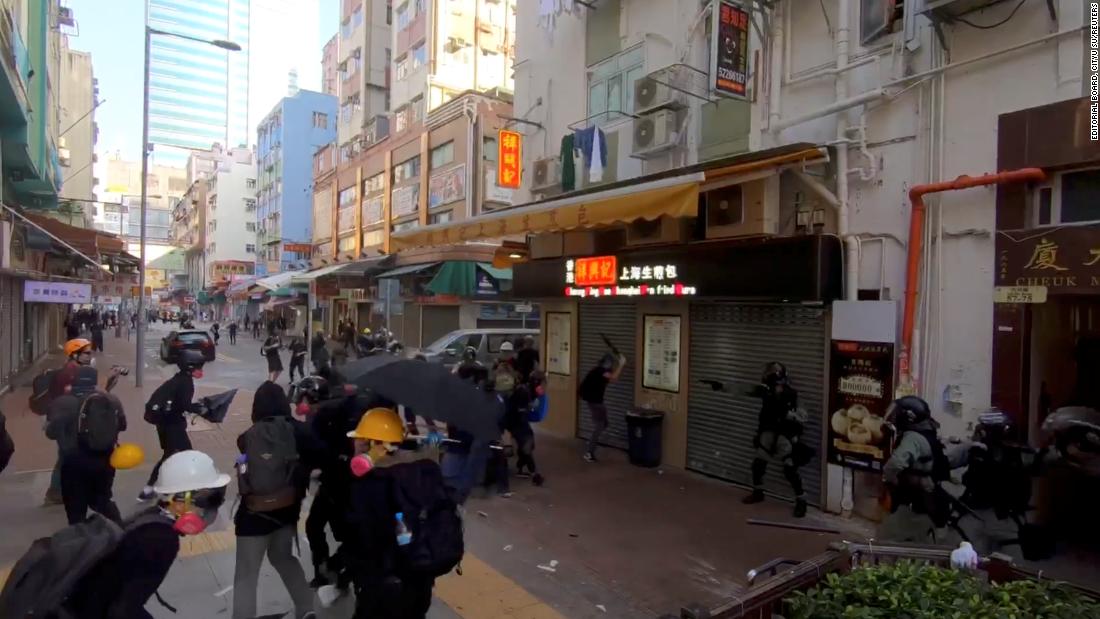
A young protester was shot Tuesday, October 1, as violent protests erupted across Hong Kong on the 70th anniversary of the People's Republic of China. The incident marked a major escalation in violence that could galvanize the protest movement in Hong Kong.

Police detain an anti-government protester on October 1. Thousands of black-clad protesters marched in central Hong Kong as part of multiple pro-democracy rallies.

Protesters stand surrounded by smoke from tear gas shells on October 1.

Marching anti-government protesters are seen through a window with peeled-off posters on October 1.

Police tackle and arrest pro-democracy protesters during clashes on October 1.
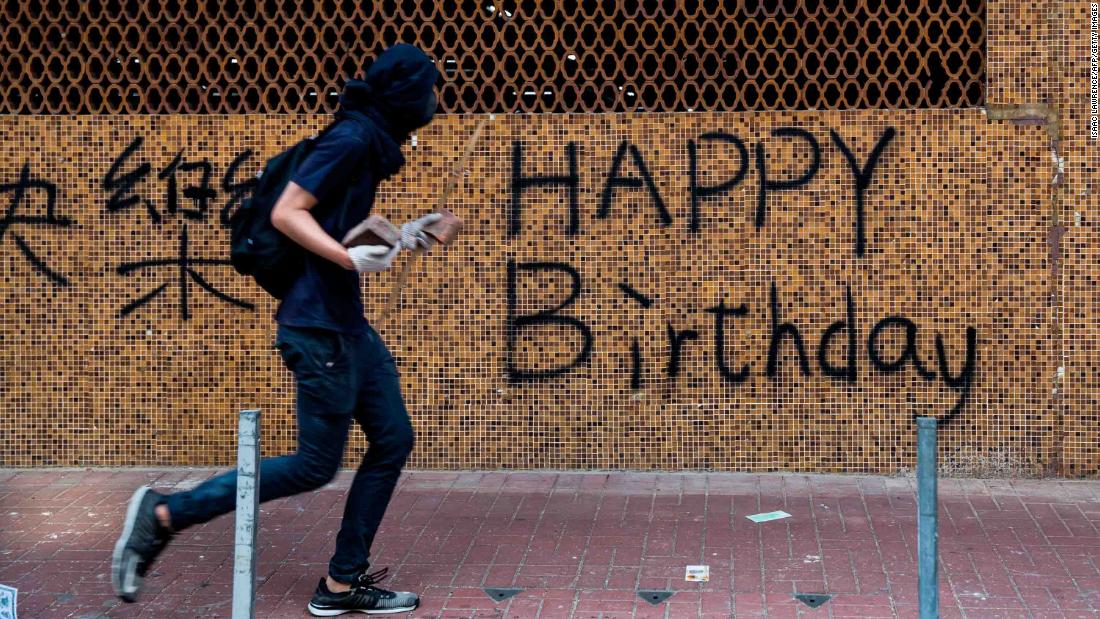
A protester is seen carrying rocks on a street on October 1. While events in Beijing were being held to mark the 70th anniversary of the founding of the People's Republic of China, demonstrators rallied throughout Hong Kong.

Protesters react after police fired tear gas near the central government offices in Hong Kong's Admiralty area on October 1.
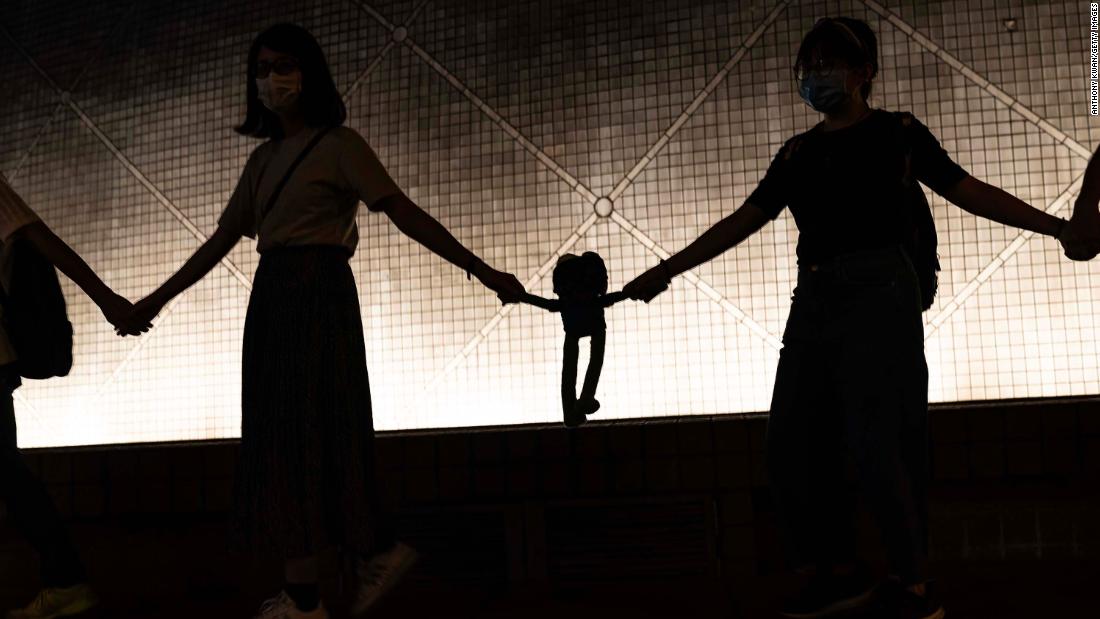
Pro-democracy protesters form a "Pepe the Frog" themed human chain on Monday, September 30.

A man is detained by Hong Kong police during a protest in the Causeway Bay shopping district on Sunday, September 29.

Riot police try to disperse protesters on September 29.

Bus passengers look at a burning barricade lit by pro-democracy protesters in front of the Mong Kok police station on Sunday, September 22.

Pro-democracy protesters sing songs and chant slogans during a rally inside a shopping mall on September 22.

An anti-government protester throws a Molotov cocktail during a demonstration near the Central Government Complex on Sunday, September 15.

A pro-China supporter, center, is escorted by police after confronting journalists in Hong Kong on September 15.

Pro-government and anti-government supporters chant against one another at a shopping mall in Hong Kong on Friday, September 13. The sign translates to "Stop violence and curb chaos; safeguard Hong Kong."

Demonstrators hold up their cell phone lights as they form a human chain at the Peak, a tourist spot in Hong Kong, on September 13.
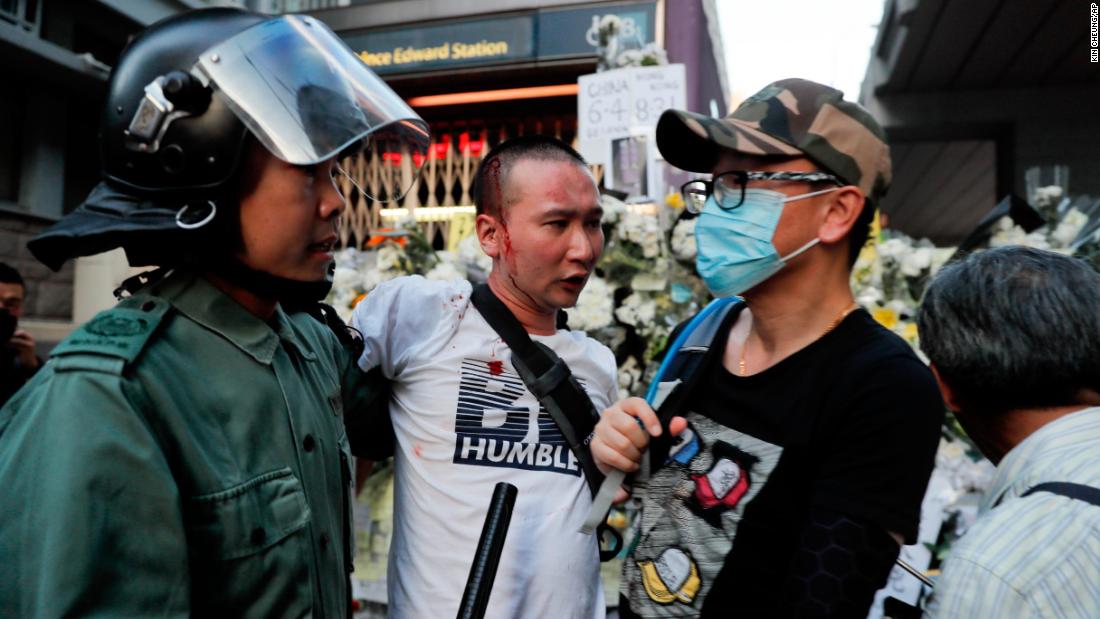
Police escort an injured man after he attacked protesters outside Prince Edward station in Hong Kong on Friday, September 6.
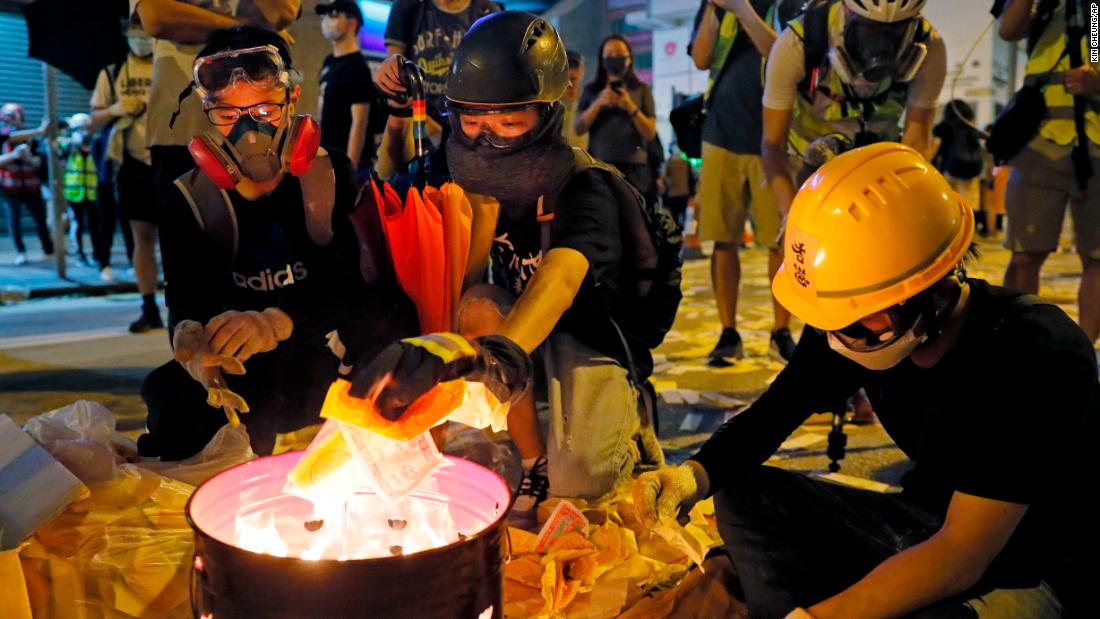
Protesters burn paper money to pay their respects to injured protesters.
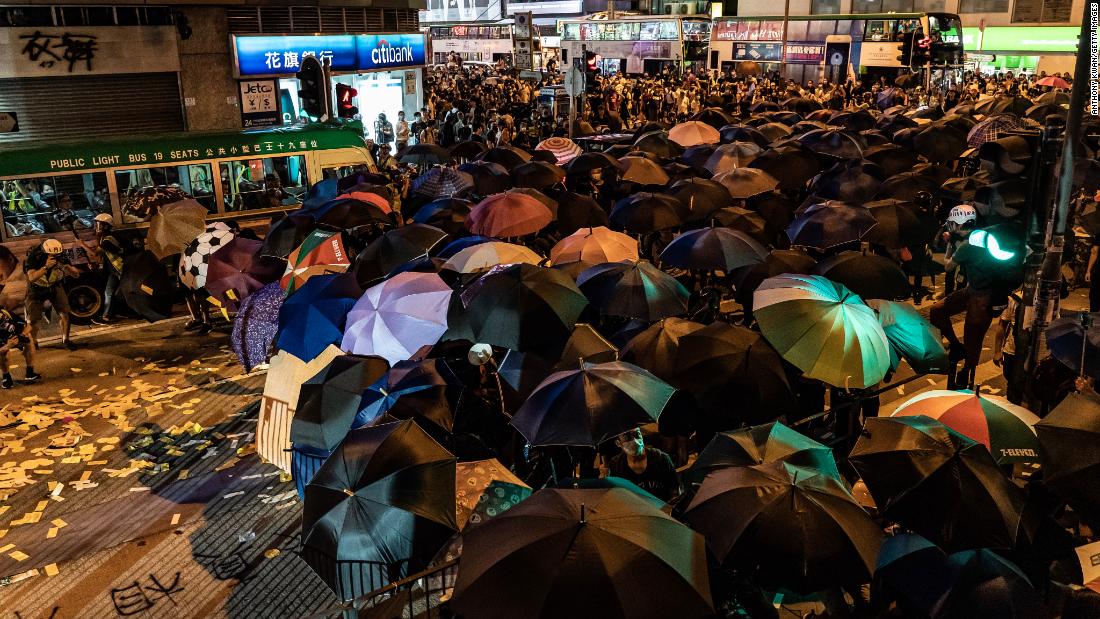
Protesters prepare to clash with police outside the Mong Kok police station on September 6.

A protester is detained by police at the Po Lam Mass Transit Railway station on Thursday, September 5.

A man watches televisions at a store in Hong Kong as Chief Executive Carrie Lam announces the withdrawal of the extradition bill on Wednesday, September 4.
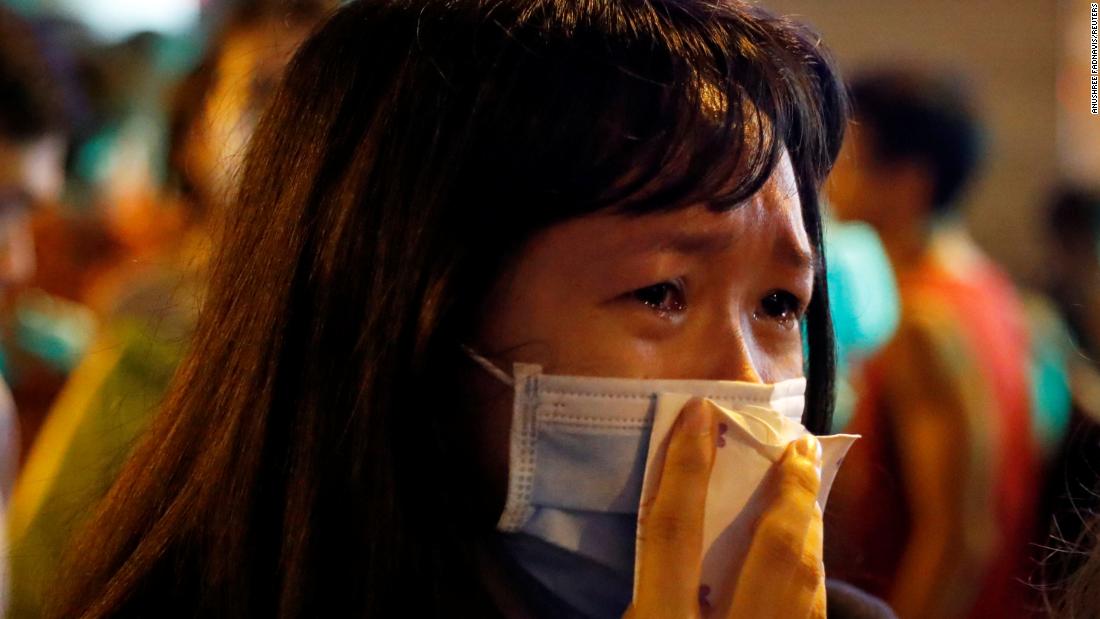
A woman gets emotional on September 4 while paying her respects to protesters who were injured a few days earlier.

Demonstrators travel through a railway station during a rally on Tuesday, September 3.

Students wearing gas masks and helmets hold a banner that reads "five major demands are indispensable" at St. Francis' Canossian College in Hong Kong.

Protesters gather in the bus terminal at Hong Kong International Airport on Sunday, September 1. Hundreds of pro-democracy activists attempted to block transport routes to the city's airport.

A passenger walks to the airport on September 1 as pro-democracy protesters blocked a road outside the airport.

A protester uses a slingshot outside the Central Government Complex during clashes with police on Saturday, August 31. Thousands of pro-democracy protesters held an anti-government rally one day after several leading activists and lawmakers were arrested in a sweeping crackdown.
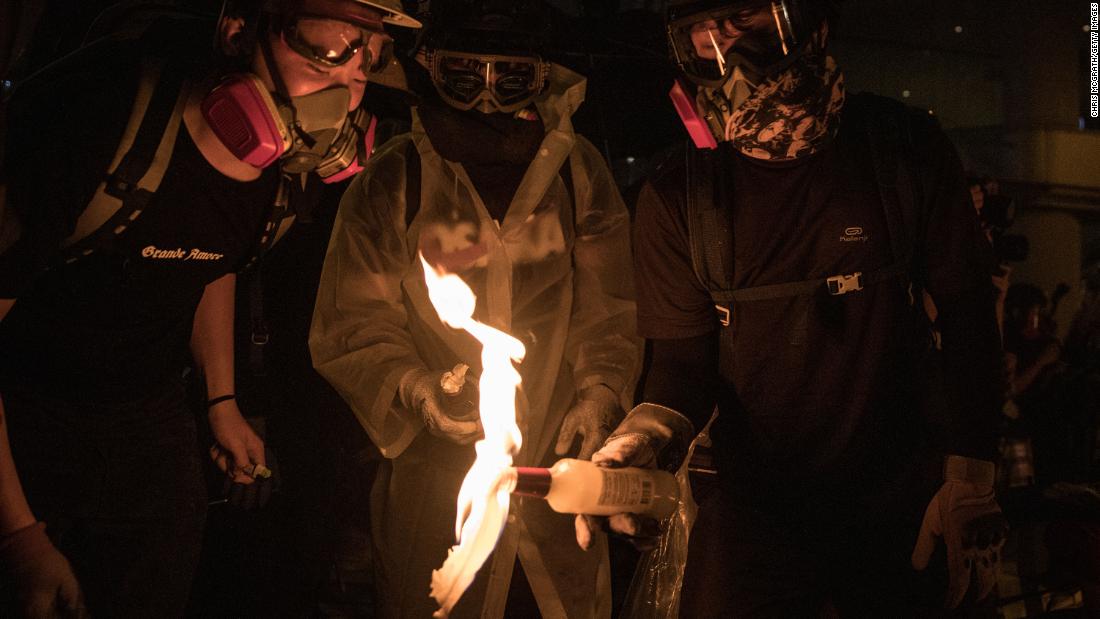
Protesters light a Molotov cocktail on August 31.

Police officers move forward during clashes with protesters on August 31.
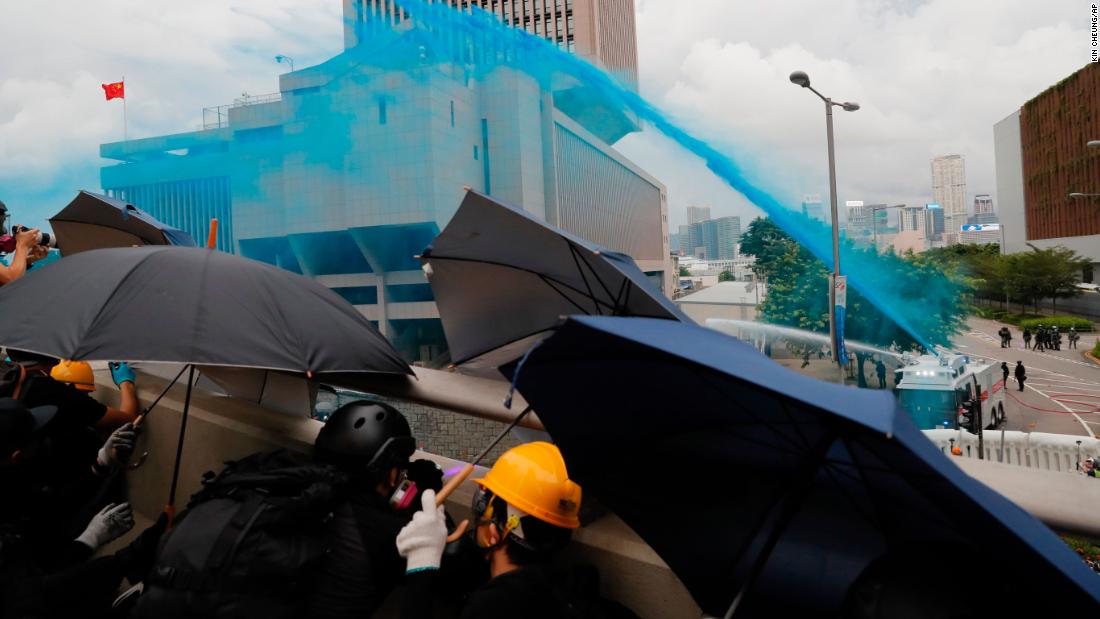
Protesters take cover as policemen fire blue-colored water on them. Blue dye can be used to stain and identify masked protesters.
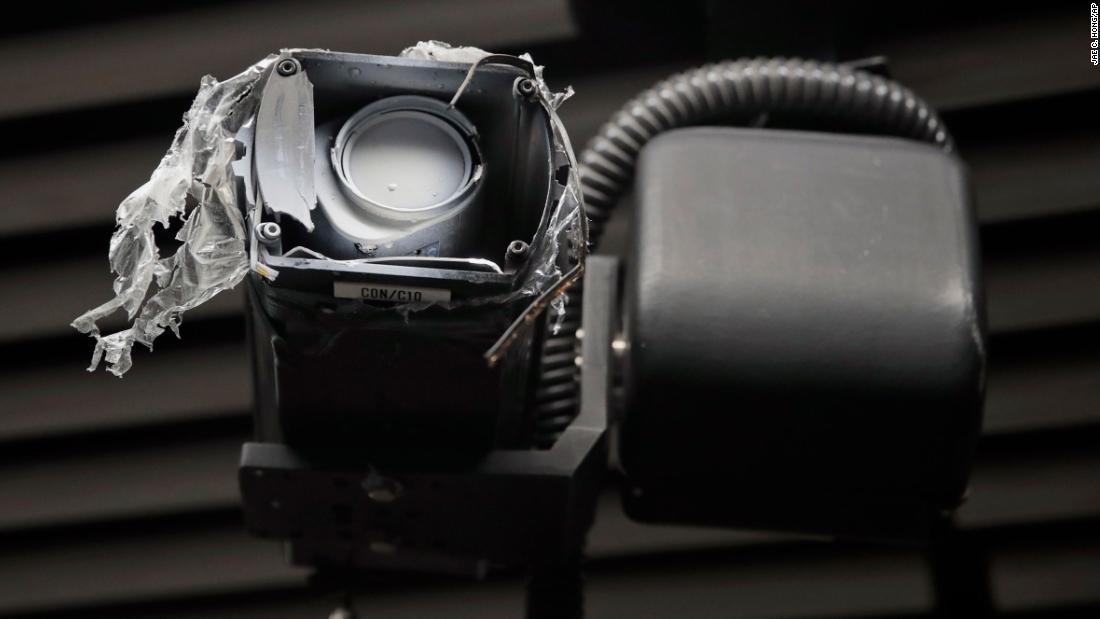
A surveillance camera is covered with white paint during protests.

An overhead view shows protesters reacting after police fired tear gas on August 31.

Pro-democracy activists Agnes Chow and Joshua Wong speak to the media after they were released on bail at the Eastern Magistrates Courts on Friday, August 30. They were arrested earlier the same day in a dragnet across Hong Kong.

Protesters clash with police after a rally in Hong Kong's Tsuen Wan district on Sunday, August 25. It was one of the most violent nights seen in Hong Kong since mass protests began in June.
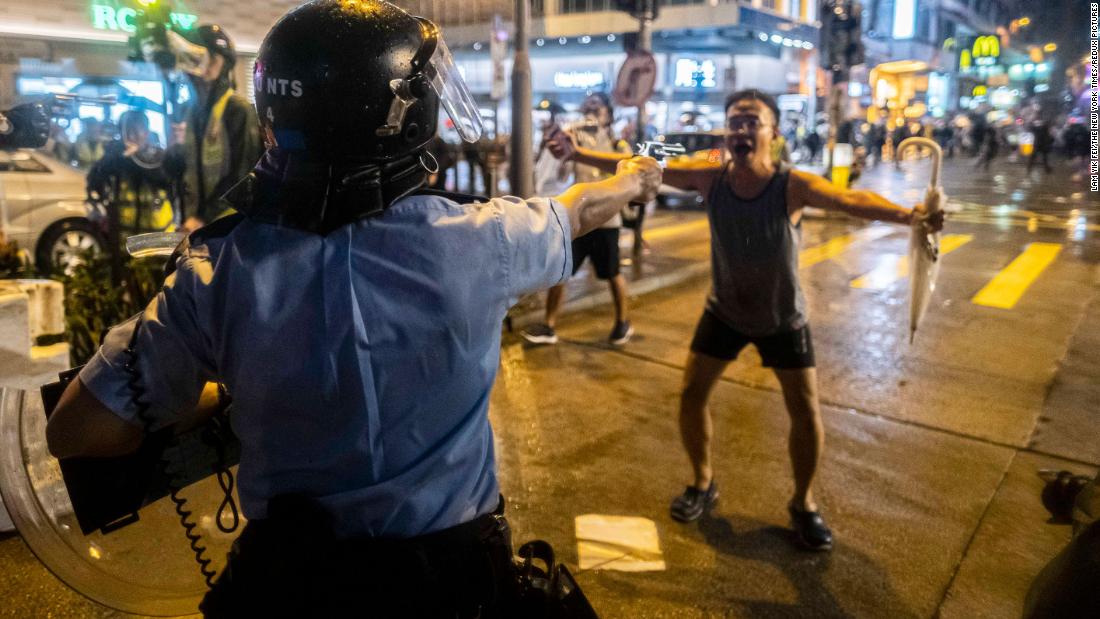
A police officer aims a gun in front of a protester on August 25.

Some protesters shine laser pointers at police lines on August 25.

Protesters and police clash on Saturday, August 24.
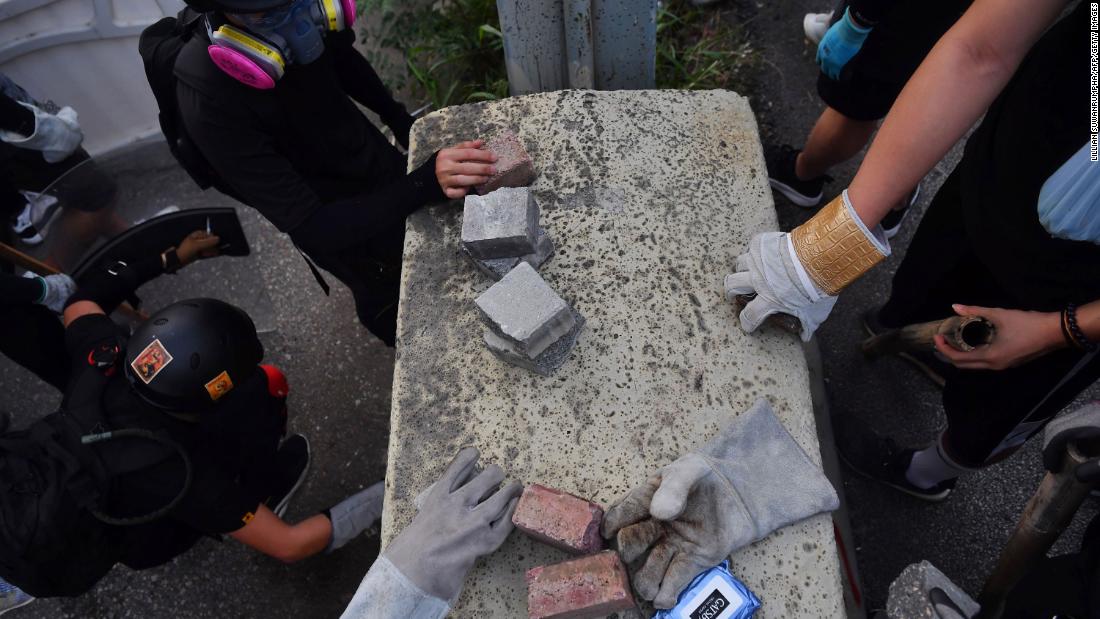
Protesters pick up bricks to be used as projectiles on August 24.
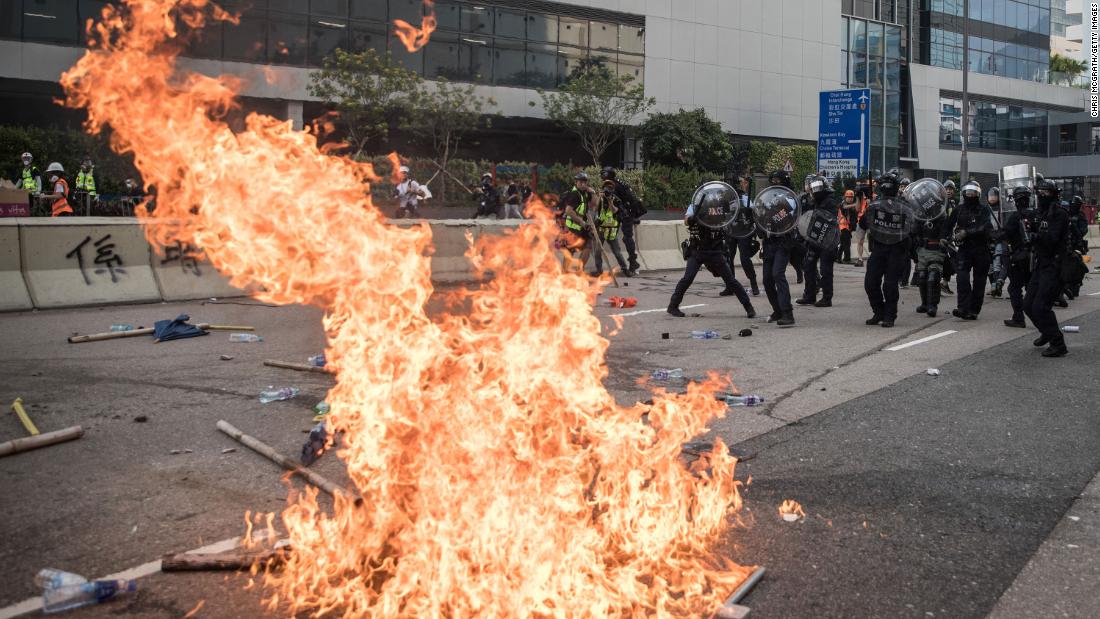
Police retreat after clashing with protesters on August 24.

People link hands as they gather at the Tsim Sha Tsui waterfront on Friday, August 23. Protesters formed a human chain across Hong Kong in a show of solidarity.

Cell phones shine from the top of Lion Rock on August 23.

Protesters march under umbrellas on Sunday, August 18.
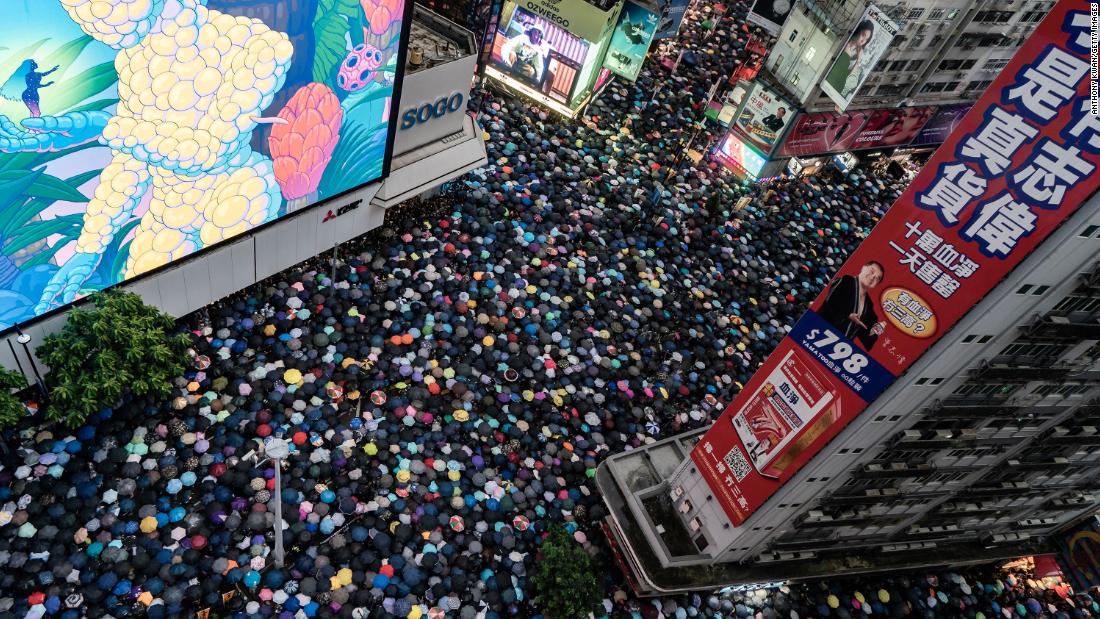
Tens of thousands of protesters showed up in the streets on August 18.
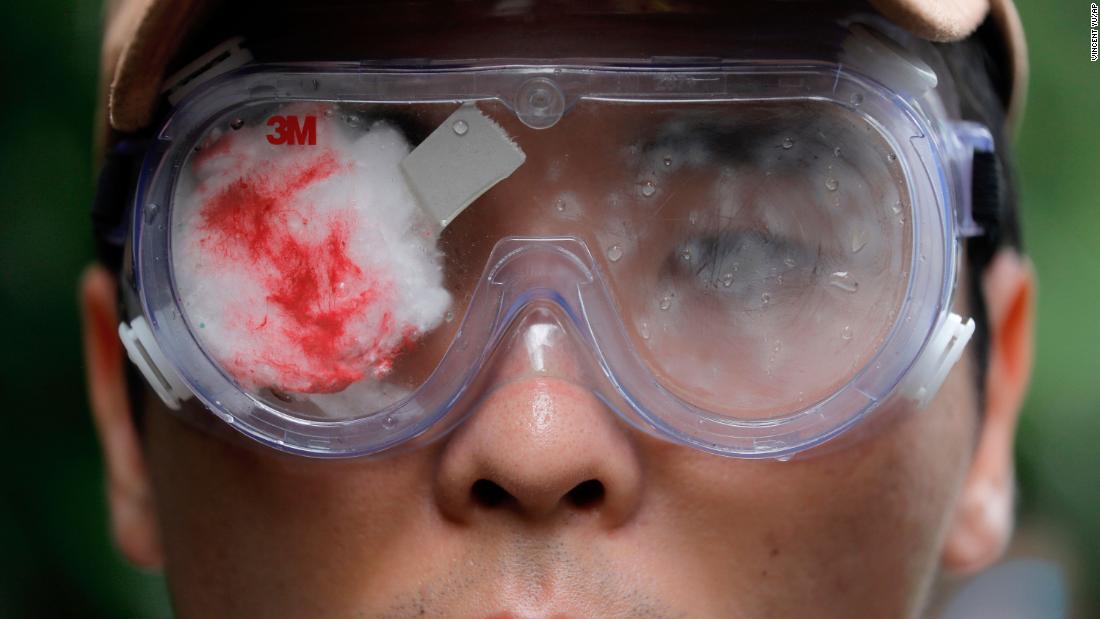
A protester participates in a march on Saturday, August 17. His eye is covered with red gauze, referencing a woman who was allegedly shot in the eye with a beanbag round during clashes between protesters and police.

Protesters react after police fired tear gas to disperse a demonstration at the Sham Shui Po police station in Hong Kong on Wednesday, August 14.

Protesters point lasers at the Sham Shui Po police station on August 14.
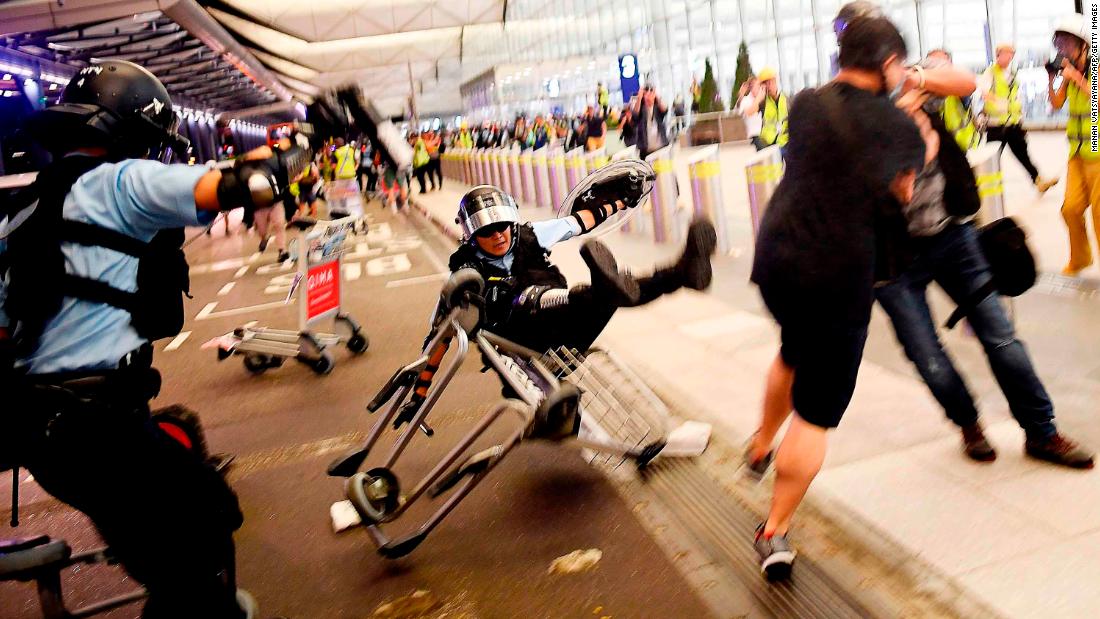
A police officer falls over an airport luggage trolley during a scuffle with pro-democracy protesters on Tuesday, August 13. For two days, protesters flooded the airport. Check-ins were suspended and dozens of outgoing flights were canceled.

Police use pepper spray to disperse protesters at the airport on August 13.

Police and protesters clash at the airport on August 13. The violence came after Hong Kong's Airport Authority announced that all check-in services would be suspended for another night because of terminal operations being "seriously disrupted."

A traveler passes her luggage to security guards as she tries to enter the departures gate.
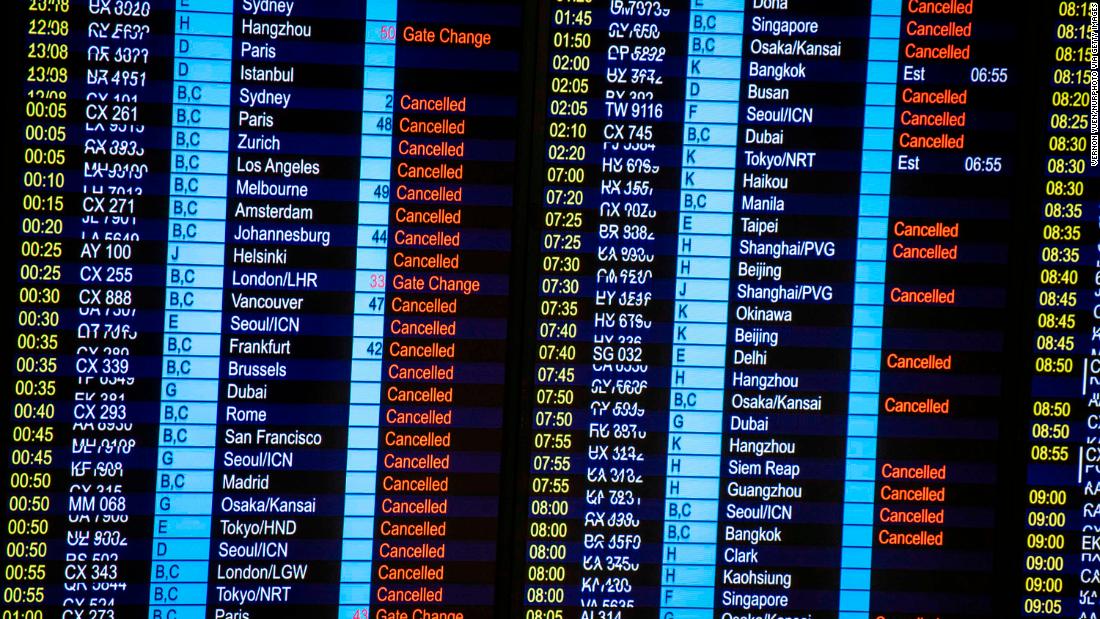
A display board shows canceled flights on August 13.

Anti-government protesters stand at a barricade made of luggage trolleys during a demonstration at the airport on August 13.

Medics look after a woman who received a facial injury during clashes on Sunday, August 11.
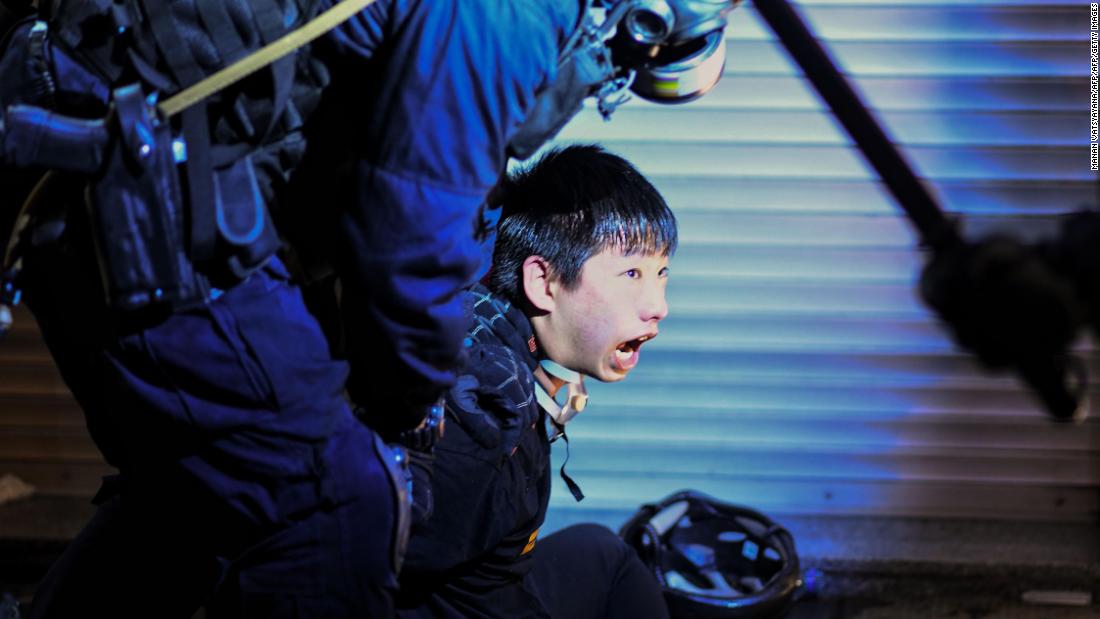
A pro-democracy protester is held by police outside the Tsim Sha Tsui police station on August 11.

Police fire tear gas at protesters during a demonstration in the Wong Tai Sin District on Monday, August 5.

A train passenger gestures toward a protester, right, who was preventing the doors of a train from closing on August 5. The protester was trying to disrupt Hong Kong's morning rush-hour commute.

A man lies down on an underground train during a protest on August 5.
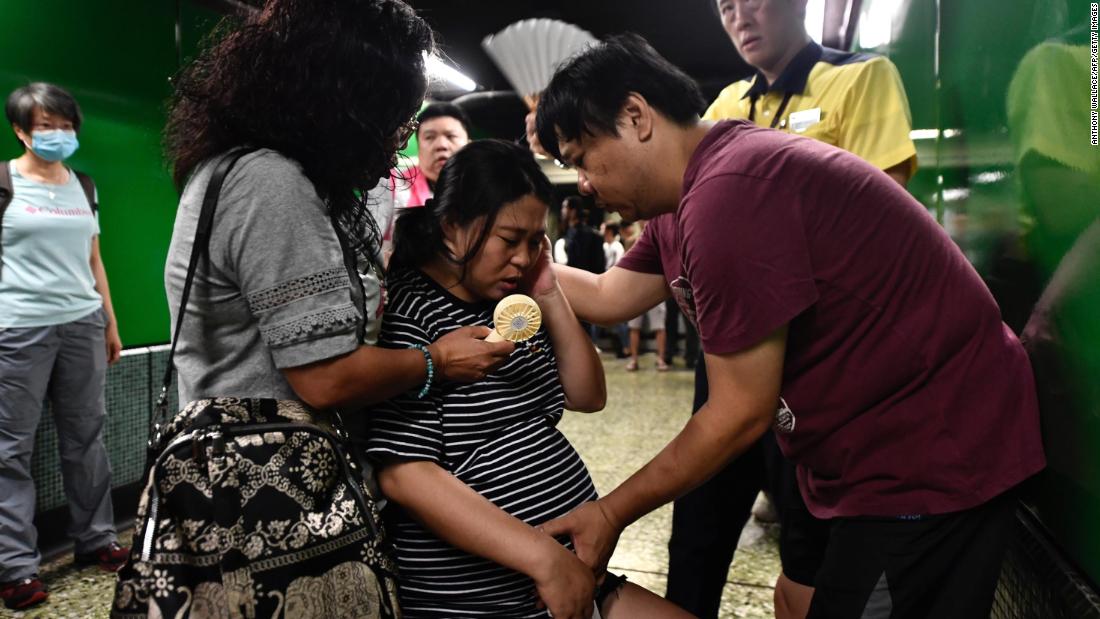
A man comforts his pregnant wife near a train platform after protesters blocked the train doors on August 5.

A protester stands in tear gas during a confrontation with police in the early hours of Sunday, August 4.

A Chinese flag floats in water after it was thrown by protesters during a demonstration on Saturday, August 3.

A protester sprays paint on a wall on August 3.
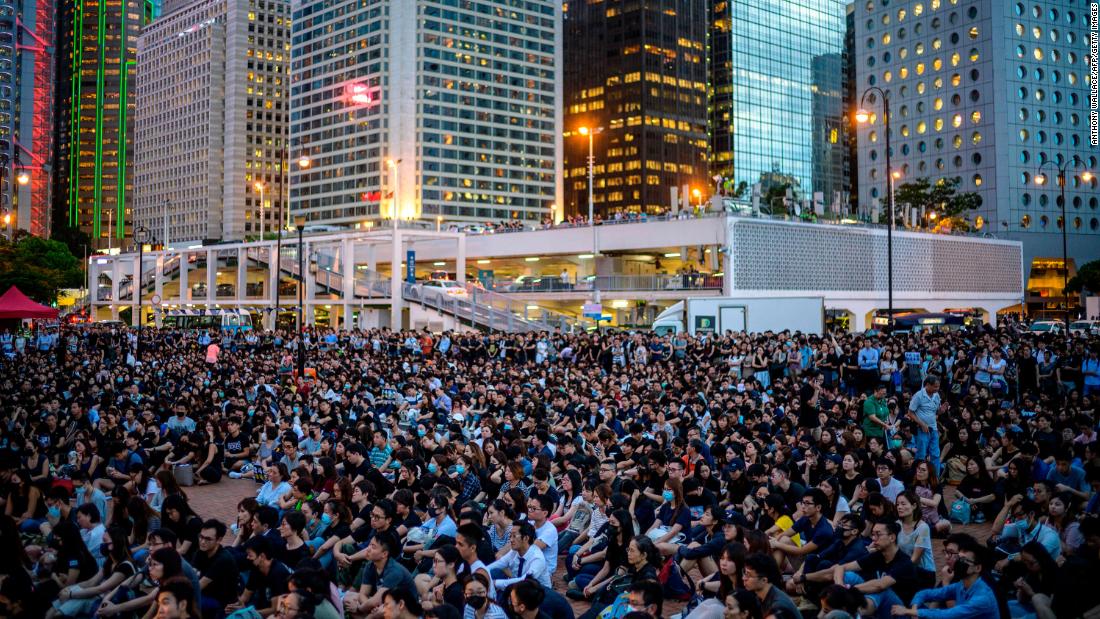
Members of Hong Kong's medical sector attend a protest in Edinburgh Place on Friday, August 2.

The emblem on the China Liaison Office is protected by plexiglass during a demonstration on Sunday, July 28.

A protester flees from baton-wielding police in the Yuen Long district of Hong Kong on Saturday, July 27.

A protester looks through umbrellas during the clashes with police on July 27.

Travelers watch as protesters rally at Hong Kong's international airport on Friday, July 26.

Protesters clash with police on Sunday, July 21.

Masked men in white T-shirts are seen after attacking anti-extradition bill demonstrators at a train station in Yuen Long.
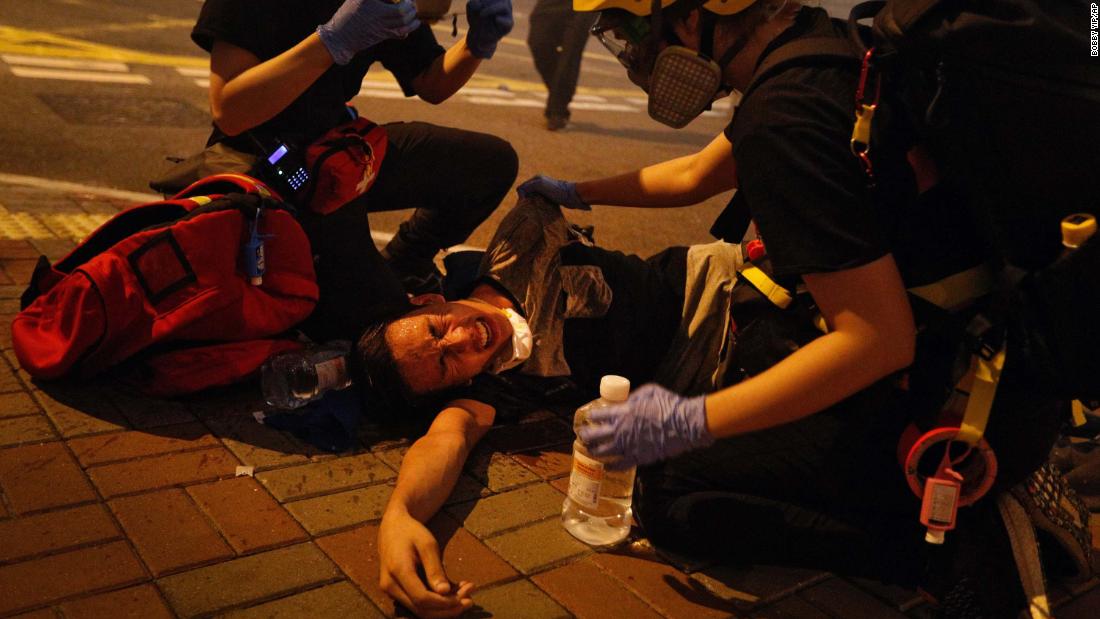
Medical workers help a protester affected by tear gas on July 21.
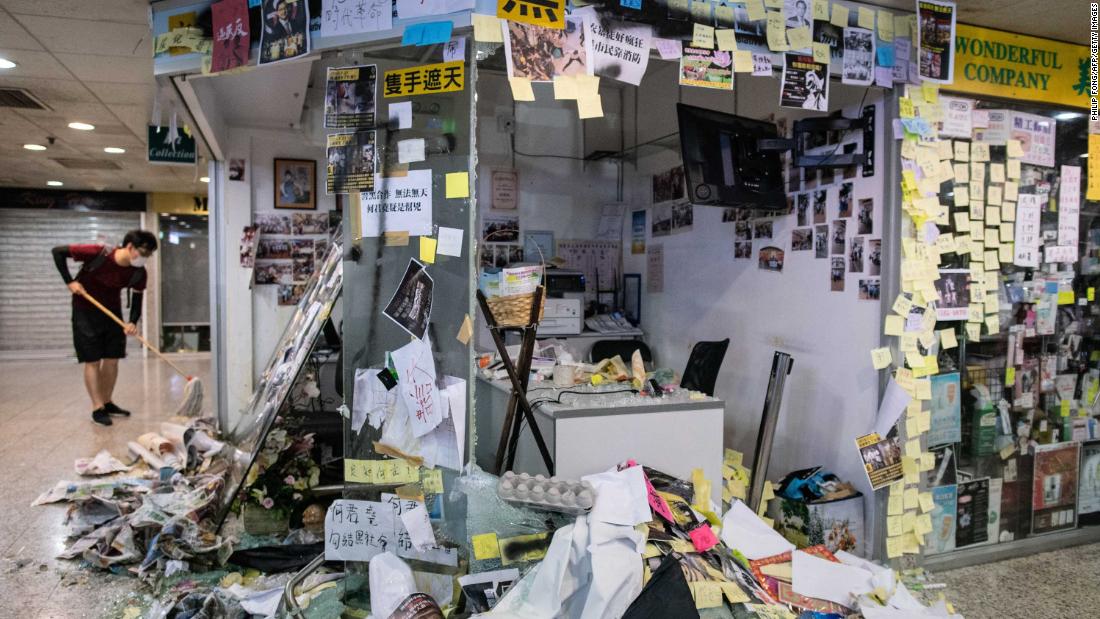
The office of pro-Beijing lawmaker Junius Ho was trashed by protesters in Hong Kong's Tsuen Wan district.

Police officers use pepper spray to disperse protesters after a rally in the Sheung Shui district on Saturday, July 13.
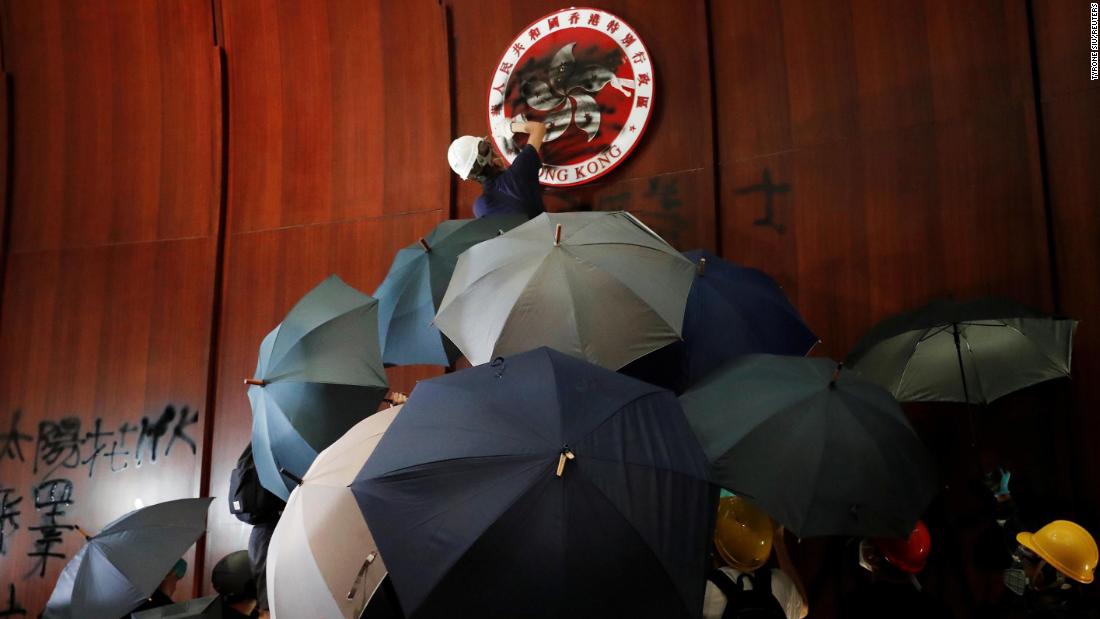
A demonstrator sprays paint inside a chamber at Hong Kong's Legislative Council building, where protesters forced their way in on Monday, July 1.

The meeting hall of the Legislative Council is taken over by demonstrators on July 1.

A protester smashes a window of the Legislative Council building.

Columns of sunlight are cast on a crowd during the march on July 1.

Helicopters carrying the flags of China and Hong Kong fly over demonstrators on July 1.

Pro-democracy lawmaker Roy Kwong rallies demonstrators with a megaphone on July 1.
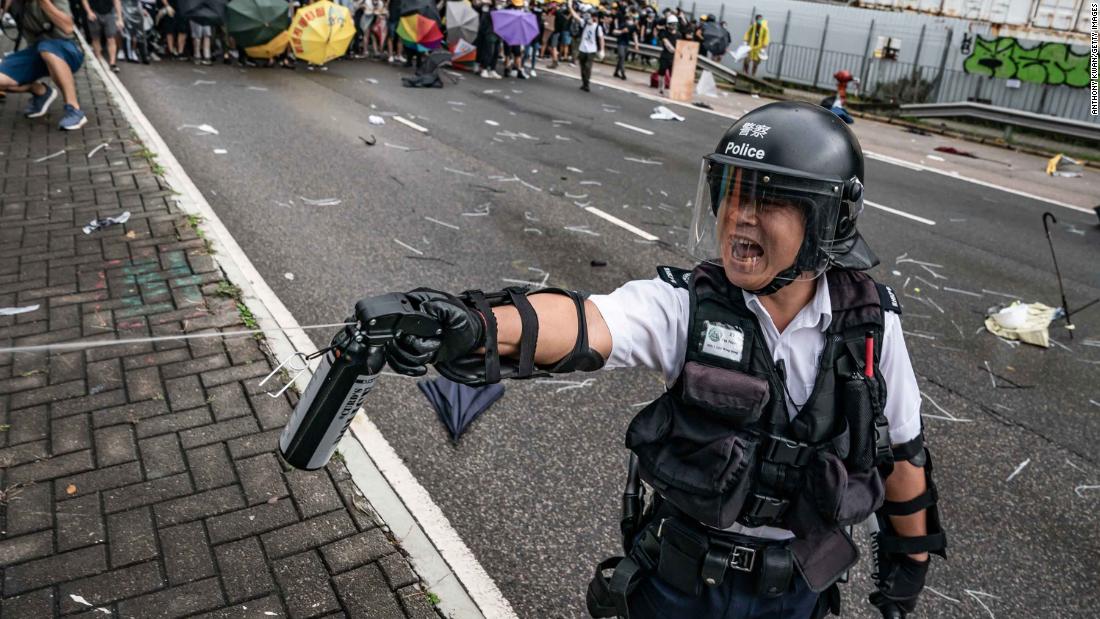
A police officer uses pepper spray during a clash with protesters on July 1.
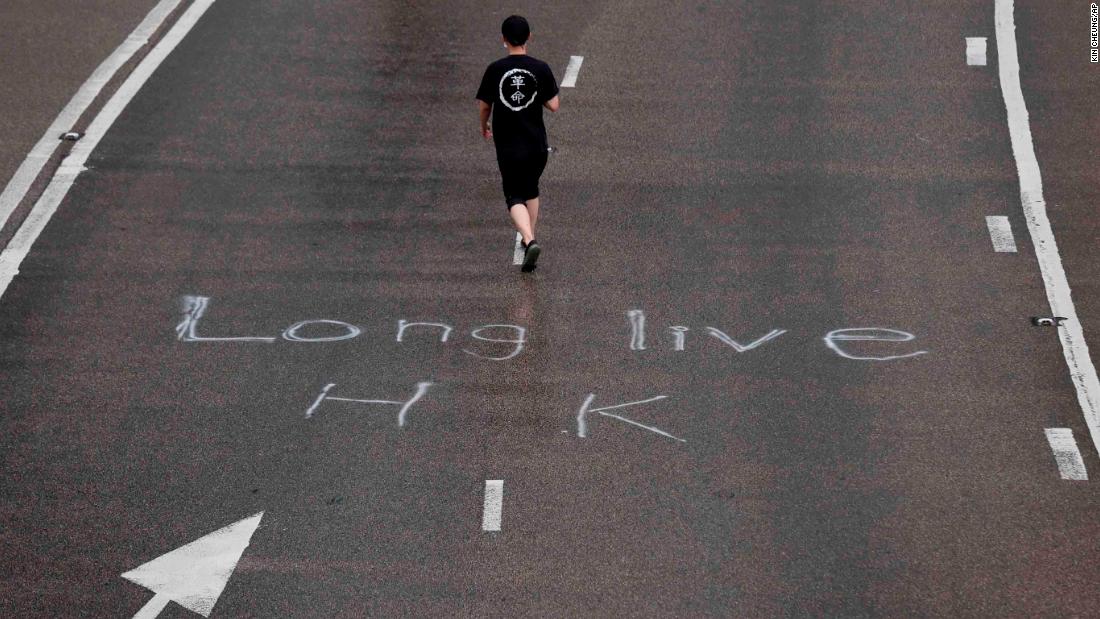
A protester wearing a T-shirt with the word "revolution" walks past an inscription on a road that reads "Long Live HK."

Police detain protesters near the government headquarters in Hong Kong on July 1.

An overhead view shows thousands of protesters marching through a Hong Kong street on Sunday, June 16.

Protesters run after police fired tear gas on Wednesday, June 12.

Protesters face off with police during the rally on June 12.
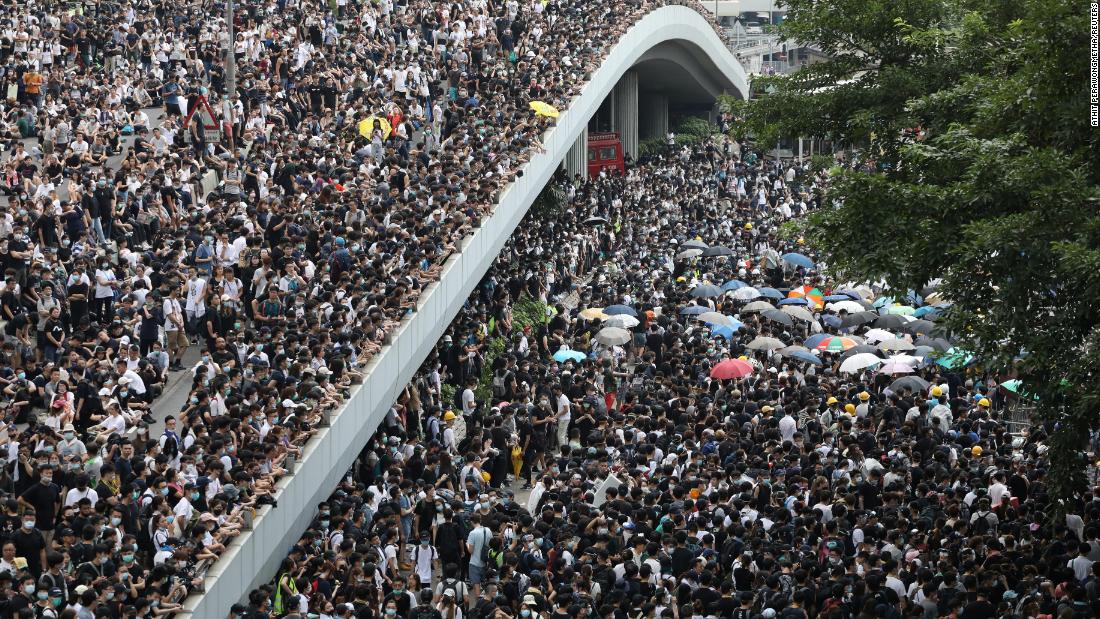
By the morning of June 12, tens of thousands of mainly young people had arrived in the area, blocking streets and bringing central Hong Kong to a standstill.

A demonstrator holds a sign during the June 12 rally.
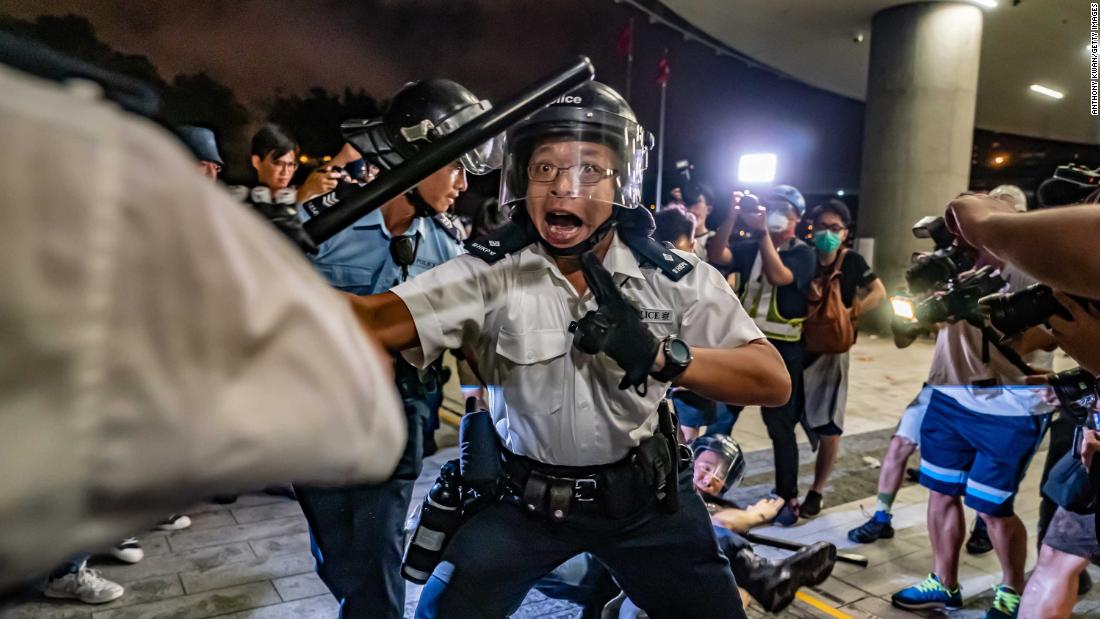
Police officers charge toward protesters during clashes on Monday, June 10. It was a continuation of protests that started the day before.

Protesters hold pictures of Hong Kong Chief Executive Carrie Lam on Sunday, June 9.
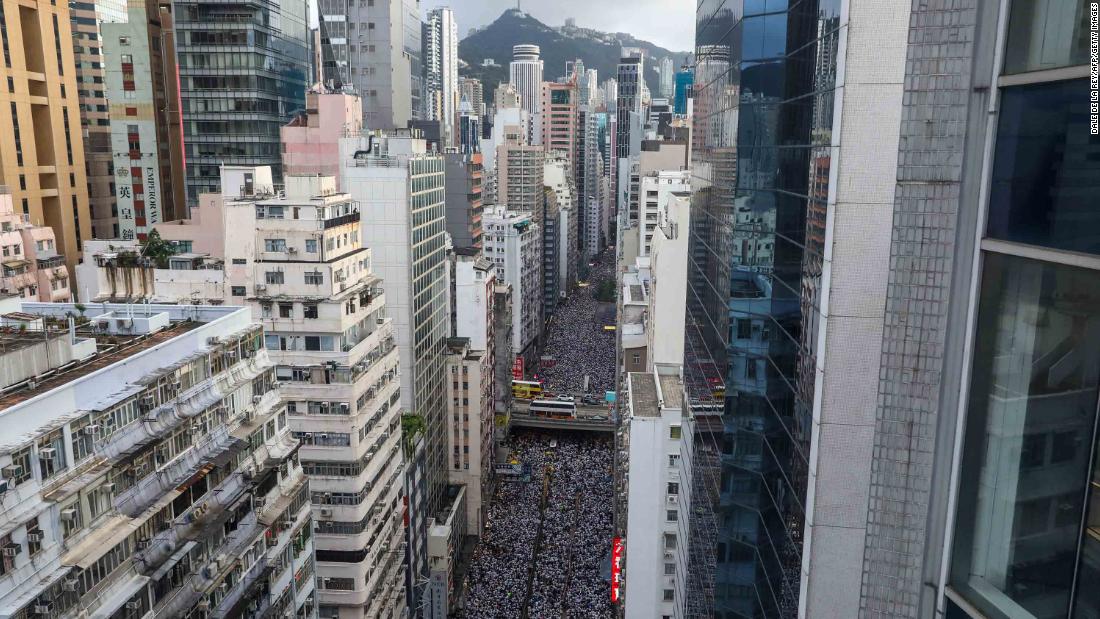
Protesters on June 9 waved placards and wore white -- the designated color of the rally. "Hong Kong, never give up!" some chanted.
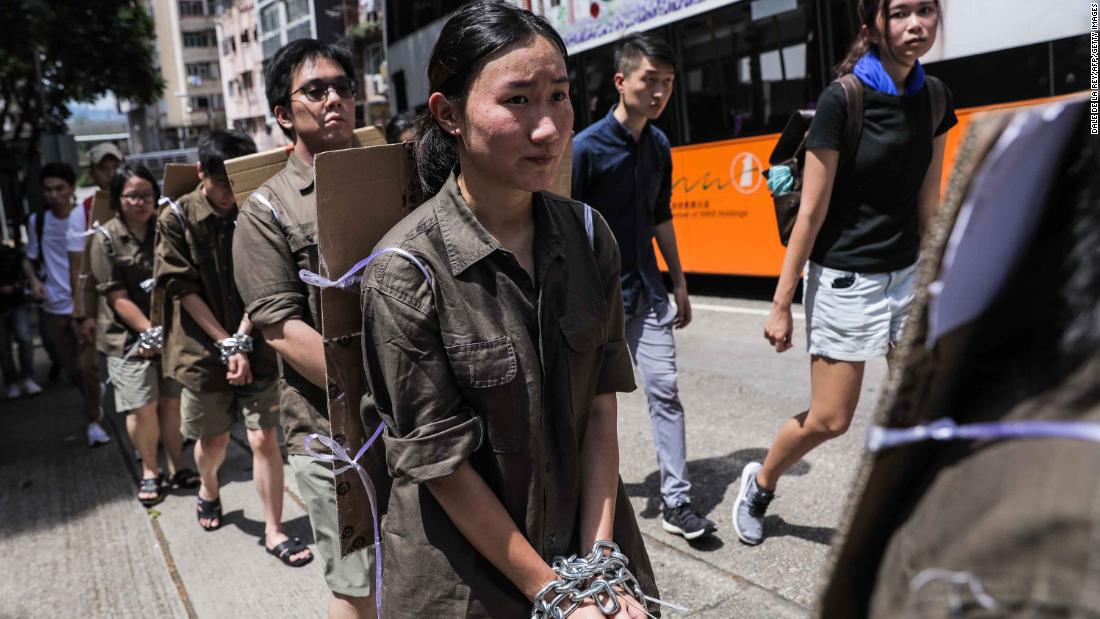
Students wear chains during a demonstration on Saturday, June 8.
The dividing line of privilege
A common refrain among the movement is that the critics don't understand the struggle because they have less of a personal stake in it. Maybe they're wealthy, or an expat, or hold dual citizenship so they can leave Hong Kong anytime -- their privilege prevents them from fully grasping the frontliners' desperation, protesters say.
Some within the "silent majority" acknowledge this. "I understand I'm probably one of the privileged ones, none of this really affects me," said Sarah, who is of Hong Kong heritage but lived in Canada before moving to the city. "I check my privilege all the time. I understand that they're stuck here... they don't have a second passport, this is their home."
Still, she feels her privilege doesn't make her criticisms wrong, just unwelcome. In fact, that distance means "it's easy for me to be objective," she said.

Scattered merchandise inside a vandalized store during a protest in Hong Kong on October 20, 2019.
Others outright reject the notion that class or citizenship privilege has anything to do with the movement.
"I don't buy that argument," Patrick said, pointing out that the movement is diverse, drawing supporters of all ages, nationalities, and socioeconomic backgrounds.
Millie said the protesters' accusation of privilege was just an excuse. After all, she hadn't been born into wealth or privilege. She admits the protesters may be facing societal obstacles -- unaffordable living, dwindling upward mobility -- but "we've all been there," she said.
Besides, Millie added, she only has Hong Kong citizenship. This is her home too -- and the protesters are wrecking it.
Support is wavering as the protests drag on
Millie, Patrick, and Sarah had all supported the protests at the beginning, to various degrees. Sarah had been "absolutely against" the bill -- but now that it's been withdrawn, and the destruction has stretched on, "I don't support (the protesters) at all," she said.
Even some of those still within the movement are beginning to pull back. After the shock of the airport mob attack, Jose questioned whether she could continue supporting it. Eventually, she decided the answer was yes -- but she said she has disconnected somewhat, and engages less frequently than she used to.

Hong Kong protesters vandalized a shop in Mongkok district on October 20, 2019.
Yara, the education worker, said she was recently walking through a mall late one night when she saw a store that protesters had vandalized because the owners were allegedly pro-China. An elderly cleaning worker was sweeping up broken window glass and complaining to friends that despite the late hour, she couldn't go home because of the mess.
"That made me realize, we've made our point with the vandalism, haven't we?" Yara said. "We've made our point smashing the ATM machines ... If we continue, people are going to slowly start seeing this as senseless violence. At a certain point, I think we need to rein in these people."


Post a Comment